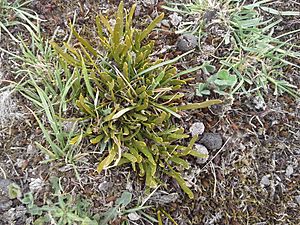Carmichaelia corrugata facts for kids
Quick facts for kids Carmichaelia corrugata |
|
|---|---|
 |
|
| Conservation status | |
 Nationally Vulnerable (NZ TCS) |
|
| Scientific classification | |
 |
|
| Occurrence data from AVH |
The Common dwarf broom (scientific name: Carmichaelia corrugata) is a special type of plant. It belongs to the pea family, called Fabaceae. You can only find this plant growing in the South Island of New Zealand.
Contents
What Does the Common Dwarf Broom Look Like?
This plant is a small shrub. It grows low to the ground, usually only 2 to 8 centimeters (about 1 to 3 inches) tall. It doesn't have leaves. Instead, it has many yellow-green branches. These branches have blunt, orange tips. They grow together to form a thick mat, often about 1 meter (3 feet) wide. The branches themselves are thin, about 1.5 to 3.5 millimeters wide. They also have grooves, like tiny lines, on them.
The Common dwarf broom has pretty flowers. They grow in pairs. Each flower is pink with a dark purple center. You can see these flowers from October to May. After the flowers, the plant grows fruit. This happens from November to June.
Where Does the Common Dwarf Broom Live?
The Common dwarf broom likes to grow in certain places. You can find it on soils made of gravel and sand. It also grows on stone and gravel ridges. Look for it near rivers, on river terraces, and in river beds. Sometimes, it even grows in places that have been disturbed, like construction sites or areas where the ground has been moved.
What's in a Name?
A scientist named William Colenso first described this plant in 1883. He gave it the scientific name Carmichaelia corrugata. The second part of its name, corrugata, comes from a Latin word. It means "wrinkled." This probably describes the grooved branches of the plant.
Why is it Important to Protect This Plant?
Scientists keep track of how many of these plants are left. This helps them know if a plant is in danger. In 2004 and 2008, the Common dwarf broom was considered "Not Threatened." This meant it was doing well.
But by 2012, things changed. It was then called "At Risk - Declining." This meant its numbers were starting to go down. By 2018, its status became "Threatened - Nationally Vulnerable." This is part of the New Zealand Threat Classification System. It means the plant is now at risk of disappearing from New Zealand if we don't protect it.

